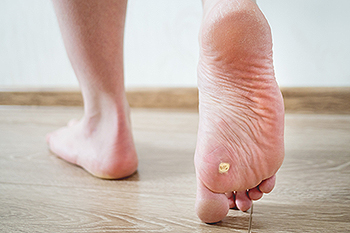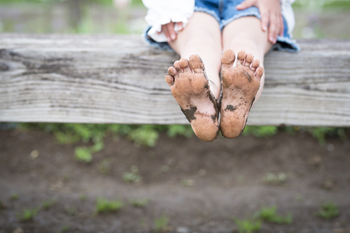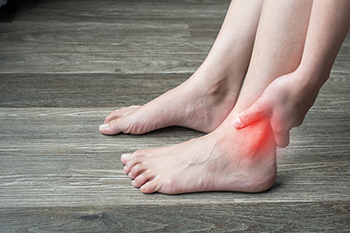
Tennis is a sport that engages your whole body and requires flexibility, strength, and endurance. As a full-body physical activity, tennis can increase a person’s risk of injuring their legs, arms, wrists, back, knees, feet, and ankles. Common tennis injuries in the feet and ankles include tennis toe and ankle sprains. Tennis toe is a simple injury that causes a toenail to hemorrhage when a toe is repeatedly forced up against the shoe’s toe box during the sport’s quick starts and stops. Tennis toe can be avoided by choosing footwear with ample room in the toe box and keeping the toenails properly trimmed. Ankle sprains occur when the ligaments that bind and support the ankle become stretched beyond their normal limits. Again, proper footwear may help to prevent some ankle sprains, specifically, sneakers with extra support in the back of the shoe help to maintain their shape. A podiatrist can treat any foot or ankle injuries that may occur while also offering additional advice on proper footwear and how best to protect yourself from future problems.
Sports related foot and ankle injuries require proper treatment before players can go back to their regular routines. For more information, contact Dr. Steven Shlonsky of Louisville, Kentucky. Dr. Shlonsky can provide the care you need to keep you pain-free and on your feet.
Sports Related Foot and Ankle Injuries
Foot and ankle injuries are a common occurrence when it comes to athletes of any sport. While many athletes dismiss the initial aches and pains, the truth is that ignoring potential foot and ankle injuries can lead to serious problems. As athletes continue to place pressure and strain the area further, a mild injury can turn into something as serious as a rupture and may lead to a permanent disability. There are many factors that contribute to sports related foot and ankle injuries, which include failure to warm up properly, not providing support or wearing bad footwear. Common injuries and conditions athletes face, including:
Sports related injuries are commonly treated using the RICE method. This includes rest, applying ice to the injured area, compression and elevating the ankle. More serious sprains and injuries may require surgery, which could include arthroscopic and reconstructive surgery. Rehabilitation and therapy may also be required in order to get any recovering athlete to become fully functional again. Any unusual aches and pains an athlete sustains must be evaluated by a licensed, reputable medical professional.
If you have any questions please feel free to contact our office located in Louisville, KY . We offer the newest diagnostic and treatment technologies for all your foot and ankle needs.

If you notice a flat hardened callus on the bottom of your foot with tiny black spots showing beneath the skin, you may have a plantar wart. The area might be tender, but try not to touch it. This growth may be caused by the human papillomavirus (HPV), which is highly contagious and can enter your body through cuts or sores. The most common places to come into contact with HPV are swimming pools, locker rooms, and bathroom floors, all areas in which you are more likely to walk barefooted. Generally speaking, plantar warts are not dangerous, but they do spread rapidly. The most effective preventative method is to wear foot coverings in places where the virus thrives. If plantar warts become a common occurrence, refuse to go away on their own, or inhibit your ability to walk, it is a good idea to visit a podiatrist for guidance and a range of treatment options.
Plantar warts can be very uncomfortable. If you need your feet checked, contact Dr. Steven Shlonsky from Louisville, Kentucky. Dr. Shlonsky will assist you with all of your foot and ankle needs.
About Plantar Warts
Plantar warts are the result of HPV, or human papillomavirus, getting into open wounds on the feet. They are mostly found on the heels or balls of the feet.
While plantar warts are generally harmless, those experiencing excessive pain or those suffering from diabetes or a compromised immune system require immediate medical care. Plantar warts are easily diagnosed, usually through scraping off a bit of rough skin or by getting a biopsy.
Symptoms
Treatment
To help prevent developing plantar warts, avoid walking barefoot over abrasive surfaces that can cause cuts or wounds for HPV to get into. Avoiding direct contact with other warts, as well as not picking or rubbing existing warts, can help prevent the further spread of plantar warts. However, if you think you have developed plantar warts, speak to your podiatrist. He or she can diagnose the warts on your feet and recommend the appropriate treatment options.
If you have any questions please feel free to contact our office located in Louisville, KY . We offer the newest diagnostic and treatment technologies for all your foot and ankle needs.
Plantar warts are described as small growths that appear on the heels or other areas of the feet that bear a large amount of weight. The pressure in these areas causes plantar warts to hide behind thick layers of skin called calluses. In most cases, plantar warts are not a serious health issue, and they usually go away without treatment. However, it is still important be mindful of them.
Plantar warts are caused by infections with human papillomavirus (HPV) in the outer layer of skin on the soles of the feet. The plantar warts then develop when the virus enters the body through weak spots at the bottom of the feet, such as tiny cuts and breaks. Plantar warts are not guaranteed for all who encounter the virus. Everyone responds differently to the affects of HPV.
Plantar warts are most common in the following groups: children and teenagers, people with weakened immune systems, people with history of plantar warts, and people who walk barefoot. Exposure to HPV is common in environments such as locker rooms or pool areas.
One of early signs to look out for is a callus, since many plantar warts hide behind them. You can also locate these warts by looking for small, fleshy, rough, grainy growths near the base of the toes and the heel. Early signs of plantar warts are shown by black pinpoints, which are small, clotted blood vessels. Lesions that interrupt normal lines and ridges in the skin of your foot may also be a sign of plantar warts. Any feeling of pain while walking or standing can also be a symptom of plantar warts.
Although most cases are not serious, some conditions may require a visit to your podiatrist. If you are uncertain that your lesion is a wart, if you have diabetes, or if you are experiencing bleeding, you may need to see a seek professional treatment. Your doctor may offer treatments such as prescribing stronger peeling medicine or using cryotherapy by applying liquid nitrogen to the wart. More serious cases may require minor surgery or laser treatment.
There are simple solutions available to help prevent plantar warts. One common task is to avoid walking barefoot in swimming pool areas and locker rooms, as this is where HPV is commonly present. Keeping your feet clean and dry, while changing shoes and socks daily can also help prevent future plantar warts. If you know someone who has plantar warts, it is important to avoid direct contact with their warts. You should also refrain from picking or scratching your wart if you happen to develop one.

Many adults complain of plantar fasciitis, which is a painful condition caused by inflammation of the band of tissue that runs from the heel to the toes. This can also be found in children, especially those who participate in sports that involve a lot of running and jumping. Dancers, runners, and basketball players may be more susceptible because the plantar fascia absorbs the pounding of every impact with the floor or ground. This results in pain at the bottom of the heel, typically a result of repetitive use. The pain generally worsens after activity and increases as the day goes on. The heel may be particularly painful in the morning but may lessen after stretching or walking. Plantar fasciitis can become worse from being overweight, wearing footwear that does not provide enough cushioning, tight calf muscles, high arches, and flat feet. If your child complains of heel pain on a consistent basis, it is a good idea to consult a podiatrist to see if plantar fasciitis may be causing the problem.
The health of a child’s feet is vital to their overall well-being. If you have any questions regarding foot health, contact Dr. Steven Shlonsky of Louisville, Kentucky. Dr. Shlonsky can provide the care you need to keep you pain-free and on your feet.
Tips for Keeping Children's Feet Healthy
If you have any questions, please feel free to contact our office located in Louisville, KY . We offer the newest diagnostic and treatment technologies for all your foot care needs.

Athlete’s foot is a common and contagious fungal infection of the skin. Common symptoms are dry, red, and cracked skin that generally develops on the bottom of the foot and in between the toes. It can spread to the toes and other areas of the foot if it is not promptly treated. This fungus can be uncomfortable and cause irritability and embarrassment. There are effective methods that can help to prevent athlete’s foot. These include wearing appropriate shoes while in public shower rooms or locker rooms and keeping your feet washed and thoroughly dried regularly. Additionally, it is advised to refrain from sharing shoes and socks. It is beneficial to wear shoes that are made of natural materials as this may help the feet to feel more comfortable. There are several treatment methods that respond well to athlete’s foot and it is suggested that you consult with a podiatrist who can determine which treatment options are best for you.
Athlete’s foot is an inconvenient condition that can be easily reduced with the proper treatment. If you have any concerns about your feet and ankles, contact Dr. Steven Shlonsky from Louisville, Kentucky. Dr. Shlonsky will treat your foot and ankle needs.
Athlete’s Foot: The Sole Story
Athlete's foot, also known as tinea pedis, can be an extremely contagious foot infection. It is commonly contracted in public changing areas and bathrooms, dormitory style living quarters, around locker rooms and public swimming pools, or anywhere your feet often come into contact with other people.
Solutions to Combat Athlete’s Foot
Athlete’s foot can cause many irritating symptoms such as dry and flaking skin, itching, and redness. Some more severe symptoms can include bleeding and cracked skin, intense itching and burning, and even pain when walking. In the worst cases, Athlete’s foot can cause blistering as well. Speak to your podiatrist for a better understanding of the different causes of Athlete’s foot, as well as help in determining which treatment options are best for you.
If you have any questions please feel free to contact our office located in Louisville, KY . We offer the newest diagnostic and treatment technologies for all your foot and ankle needs.
 Ankle pain can be sharp or dull depending on the type of injury that has occurred. While some patients experience pain from ankle sprains or strains, ankle pain may stem from arthritis as well. An Achilles tendon injury can cause severe ankle pain, and this can happen due to an injury that overstretched this strong band of tissue that connects the calf muscle to the heel bone. Symptoms of a fractured ankle can include swelling surrounding the ankle, and it is often difficult to walk. Soft tissue damage can come from an ankle sprain or strain and can cause significant pain. Additionally, a medical condition known as gout can also cause ankle pain, and it is necessary to seek immediate treatment. If you have ankle pain for any reason, please consult with a podiatrist as quickly as possible so the correct treatment can begin.
Ankle pain can be sharp or dull depending on the type of injury that has occurred. While some patients experience pain from ankle sprains or strains, ankle pain may stem from arthritis as well. An Achilles tendon injury can cause severe ankle pain, and this can happen due to an injury that overstretched this strong band of tissue that connects the calf muscle to the heel bone. Symptoms of a fractured ankle can include swelling surrounding the ankle, and it is often difficult to walk. Soft tissue damage can come from an ankle sprain or strain and can cause significant pain. Additionally, a medical condition known as gout can also cause ankle pain, and it is necessary to seek immediate treatment. If you have ankle pain for any reason, please consult with a podiatrist as quickly as possible so the correct treatment can begin.
Ankle pain can have many different causes and the pain may potentially be serious. If you have ankle pain, consult with Dr. Steven Shlonsky from Louisville, Kentucky. Dr. Shlonsky will assess your condition and provide you with quality foot and ankle treatment.
Ankle pain is any condition that causes pain in the ankle. Due to the fact that the ankle consists of tendons, muscles, bones, and ligaments, ankle pain can come from a number of different conditions.
Causes
The most common causes of ankle pain include:
Symptoms
Symptoms of ankle injury vary based upon the condition. Pain may include general pain and discomfort, swelling, aching, redness, bruising, burning or stabbing sensations, and/or loss of sensation.
Diagnosis
Due to the wide variety of potential causes of ankle pain, podiatrists will utilize a number of different methods to properly diagnose ankle pain. This can include asking for personal and family medical histories and of any recent injuries. Further diagnosis may include sensation tests, a physical examination, and potentially x-rays or other imaging tests.
Treatment
Just as the range of causes varies widely, so do treatments. Some more common treatments are rest, ice packs, keeping pressure off the foot, orthotics and braces, medication for inflammation and pain, and surgery.
If you have any questions, please feel free to contact our office located in Louisville, KY . We offer the newest diagnostic and treatment technologies for all your foot care needs.
The ankle joint is the point at which the bones of the leg and foot join. This joint is crucial because it is responsible for the foot’s mobility. Ankle pain is typically the result of inflammation from an injury to bones, joint space, cartilage, ligaments, tendons, or muscles in the area. Commonly associated symptoms with ankle pain are bruising, redness, numbness, stiffness, weakness, and tingling.
The most common causes of ankle pain are sprains and injuries. Ankle sprains are one of the most common musculoskeletal injuries. Sprains occur when the ligaments of the ankle become partially or completely torn due to sudden stretching. Sprains can occur on either the inner or outer sides of the ankle joint. Usually, these injuries occur when the ankle is twisted in an activity by stepping off an uneven surface. More specific causes include rheumatoid arthritis, gout, osteoarthritis, and Achilles tendonitis.
If you are experiencing ankle pain, you should consult with your podiatrist to choose the best method of care. Your doctor will conduct an examination of your ankle to determine the underlying cause of the pain.
Fractures in the toes and metatarsals (long bones in the midfoot that connect to the toe bones) can be quite painful and should not be taken lightly. Breaks can either be traumatic (acute) that occur instantly due to an injury, or can be stress fractures which develop over time. Traumatic fractures can cause a bone to become misaligned in certain cases. You may hear a snap at the moment of impact and you may even notice that the toe is crooked or misshapen in some way. Pain may be felt at the site of the injury, and bruising and swelling may occur the following day. With a stress fracture, any pain felt while using the affected foot may subside when you rest, and although you may notice swelling there should be no apparent bruising. It is important to see a podiatrist for any broken bone in your toe or metatarsal, even if you have been treated initially at an emergency room. Proper treatment and rehabilitation will help avoid future complications like an improperly healed bone, mobility issues, difficulty wearing shoes, deformities, chronic pain, or arthritis in the joint.
A broken toe can be very painful and lead to complications if not properly fixed. If you have any concerns about your feet, contact Dr. Steven Shlonsky from Louisville, Kentucky. Dr. Shlonsky will treat your foot and ankle needs.
What to Know About a Broken Toe
Although most people try to avoid foot trauma such as banging, stubbing, or dropping heavy objects on their feet, the unfortunate fact is that it is a common occurrence. Given the fact that toes are positioned in front of the feet, they typically sustain the brunt of such trauma. When trauma occurs to a toe, the result can be a painful break (fracture).
Symptoms of a Broken Toe
Generally, it is best to stay off of the injured toe with the affected foot elevated.
Severe toe fractures may be treated with a splint, cast, and in some cases, minor surgery. Due to its position and the pressure it endures with daily activity, future complications can occur if the big toe is not properly treated.
If you have any questions please feel free to contact our office located in Louisville, KY . We offer the newest diagnostic and treatment technologies for all your foot and ankle needs.
Read more about What to Know About a Broken ToeMost heel pain is caused by a local condition occurring in the foot. The most common type of heel pain is due to plantar fasciitis—an inflammation of the long band of tissue running along the bottom of the foot, connecting the toes with the heel. Anyone can have plantar fasciitis. However, athletes and people who are obese or have diabetes, flat feet, or who wear worn out shoes, are more susceptible to developing this painful condition. Heel spurs may often occur along with plantar fasciitis because the strain on the heel bone which causes plantar fasciitis can also lead to calcium deposits forming on the bone (heel spurs). When the bursa sac at the back of the heel becomes irritated and inflamed, this is known as bursitis. A condition called “pump bump” also affects the back of the heel when pressure from wearing pumps causes a painful, bony growth to develop. Podiatrists are very experienced in treating these forms of heel pain and more, so if you experience any heel discomfort, make an appointment today.
Many people suffer from bouts of heel pain. For more information, contact Dr. Steven Shlonsky of Louisville, Kentucky. Dr. Shlonsky can provide the care you need to keep you pain-free and on your feet.
Causes of Heel Pain
Heel pain is often associated with plantar fasciitis. The plantar fascia is a band of tissues that extends along the bottom of the foot. A rip or tear in this ligament can cause inflammation of the tissue.
Achilles tendonitis is another cause of heel pain. Inflammation of the Achilles tendon will cause pain from fractures and muscle tearing. Lack of flexibility is also another symptom.
Heel spurs are another cause of pain. When the tissues of the plantar fascia undergo a great deal of stress, it can lead to ligament separation from the heel bone, causing heel spurs.
Why Might Heel Pain Occur?
Treatments
Heel pain should be treated as soon as possible for immediate results. Keeping your feet in a stress-free environment will help. If you suffer from Achilles tendonitis or plantar fasciitis, applying ice will reduce the swelling. Stretching before an exercise like running will help the muscles. Using all these tips will help make heel pain a condition of the past.
If you have any questions please contact our office located in Louisville, KY . We offer the newest diagnostic and treatment technologies for all your foot and ankle needs.
The plantar fascia is the band of tissue on the soles of the feet that connect the front of the foot with the arch and the heel. When that tissue becomes inflamed due to stress or excessive stretching, plantar fasciitis can occur. Factors that can contribute to plantar fasciitis may include prolonged standing without proper footwear support, being overweight, having flat feet, high arches, or tight calf muscles. Pain from plantar fasciitis is often worse after sitting for a long period of time or in the morning, because the plantar fascia can contract while you are inactive or sleeping. If you have heel pain, it is suggested you make an appointment with a podiatrist who can examine you to make a proper diagnosis, and help treat whatever condition you may have using a variety of treatments and therapies.
Plantar fasciitis can be very painful and inconvenient. If you are experiencing heel pain or symptoms of plantar fasciitis, contact Dr. Steven Shlonsky from Louisville, Kentucky. Dr. Shlonsky can provide the care you need to keep you pain-free and on your feet.
What Is Plantar Fasciitis?
Plantar fasciitis is the inflammation of the thick band of tissue that runs along the bottom of your foot, known as the plantar fascia, and causes mild to severe heel pain.
What Causes Plantar Fasciitis?
How Can It Be Treated?
While very treatable, plantar fasciitis is definitely not something that should be ignored. Especially in severe cases, speaking to your doctor right away is highly recommended to avoid complications and severe heel pain. Your podiatrist can work with you to provide the appropriate treatment options tailored to your condition.
If you have any questions please feel free to contact our office located in Louisville, KY . We offer the newest diagnostic and treatment technologies for all your foot and ankle needs.
Read more about Plantar Fasciitis
Louisville Podiatry Office
149 Thierman Ln
Louisville,
KY 40207
Mon: 9:30 AM - 5:30 PM
Tues: 9:30 AM - 5:30 PM
Wed: 9:30 AM - 5:30 PM
Thur: 9:30 AM - 5:30 PM
Fri: 9:30 AM - 5:30 PM